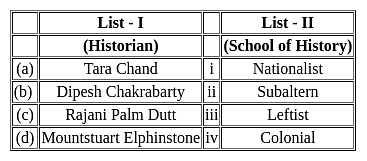TS SET Paper 2 Mock Test - 10 (History) - TS TET MCQ
30 Questions MCQ Test TS SET Mock Test Series 2024 - TS SET Paper 2 Mock Test - 10 (History)
Which of the following statements are correct about the Sakyas clan?
- It was situated near the border of Nepal.
- Mahatma Buddha’s mother belonged to this clan.
- It had a unitary constitution.
- The capital of Sakya was Kapilavastu.
Select the correct option from the codes given below:
A common feature of all Bhakti Saints was that all of them-
Who among the following is a 'leftist' historian?
Direction: Answer the following questions by selecting the correct / most appropriate options.
Statement A): The authors of 'tawarikhs' during the Delhi Sultans advised on preserving an ideal social order based on 'birthright' and 'gender distinctions'.
Statement B): Their ideas were shared by everybody.
Which of the following social reformers supported widow remarriage?
A. Ishwarchandra Vidyasagar
B. Swami Dayanand Saraswati
C. Veerasalingam Pantulu
D. Raja Rammohun Roy
Every Veda consists of which of the following parts?
- Samhita
- Brahmana
- Aranyaka
- Upanishad
Select the correct option from the codes given below:
Which of the following statements is incorrect regarding Alauddin Khalji’s administration?
Prince of Wales came to India during the viceroy-ship of who of the following?
Match the following and choose the correct option:

Which of the following statements is/are correct regarding Prarthana Samaj?
1. It didn't reject the Vedas and emphasized Bhakti towards God.
2. They were against the caste system and the practice of untouchability.
3. It opposed the idea of Widow remarriage but propagated Women's education.
In which of the following areas are the beginning of settled life associated with a Chalcolithic rather than a Neolithic phase?
1. Rajasthan
2. Malwa
3. Northern Deccan
4. Gujarat
Select the correct answer using the codes given below
At which of the following places the entry of women as Bhikshuni into the sangha was allowed by Buddha?
Which of the following Muslim rulers abolished the pilgrimage tax?
With reference to the Dual Government, consider the following statements.
1) The Dual System of Government in Bengal was the brainchild of Lord Clive in 1765.
2) The Diwani was carried out by the company so Company was Diwan.
3) The Nizamat jurisdiction was carried out by these decrepit Indians so they were Nizam.
Choose the correct statements.
Which among the following incident took place during the viceroyship of Lord Canning?
- Government of India Act of 1858 passed
- Indigo revolt
- Indian Council Act of 1861 passed
- Famine in the North-Western provinces
Choose the correct option from the codes given below :
Which of the following are the characteristics of the Christian view of history?
A. It is universal in its approach.
B. It believes in divine providence.
C. It is apocalyptic.
D. It believes in the existence of two cities.
Consider the following statements.
I. Mathura school of Buddhist art was developed by the Kushan dynasty.
II. Gandhara school of Art was developed by Sunga dynasty.
III. Amravati School was developed by the Satvahana dynasty.
Choose the incorrect statement.
Arrange the following Mughal emperors in chronological sequence:
(a) Farrukhsiyar
(b) Jahandar Shah
(c) Bahadur Shah
(d) Muhammad Shah
Select the correct option:
Which of the following is not a composition of Saint Tulsidas?
Consider the following statements regarding the Guptas:
- Srigupta was the first Gupta king whose name got mentioned in the Allahabad Pillar inscription.
- The Devichandraguptam mentioned the murder of Ramagupta by Chandragupta II.
- The Bhittari Stone Inscription mentioned the defeat of Hunas by the Skandagupta.
Which of the statements given above is/are correct?
Direction: The following item consists of two statements, statement I and statement II. Examine these two statements carefully and select the correct answer from the code given below.
Statement I:
Market reforms of Alauddin Khilji were focused on internal market restructuring apart from administrative and military necessities.
Statement II:
Allauddin tried to control the price of everything from caps to socks, vegetables, sweetmeats to chapatis etc.
Which of the following statements about Annales historians are true?
A. Annales School was name after the journal Annales.
B. Annales historians see history in terms of movement from past to the future.
C. Annales historians insist that they do not represent a school.
D. Annales school has influenced history writing in many countries including India.
With reference to Deccan Riots consider the following statements:
1. Here money lenders were mostly outsiders - Marwaris or Gujaratis.
2. Modern Nationalist Intelligentsia of Maharashtra opposed the peasants' cause due to the violence.
Which of the above statements is/are correct?
Which of the following kingdom were the prominent in 6th and 7th centuries BC?
Which of the following text was found in the Aryan expansion of 6th and 7th centuries BC?
Consider the following statements.
I. Non-Violence is not to be compromised within Buddhism.
II. Buddhism advocated ‘Gnana Marga’.
III. Mahavira remained silent and agnostic about the existence of God.
Choose the correct statement.
Choose the correct pair:
1) Sahukar: acted as both a moneylender and a trader.
2) Rentier: people who lived on rental income from property.
3) Jotedars: Rich Zamindars and village headmen.
|
60 tests
|



















